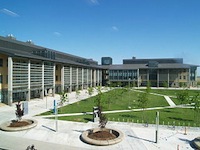Computational astronomy groups across the University of California
Below are just a few examples of astrocomputing research groups on various University of California campuses and National Loberatories within the UC-HIPACC consortium.
UC Berkeley
UC Irvine
UC Los Angeles
UC Merced
UC Riverside
UC San Diego
UC Santa Cruz
Lawrence Berkeley National Laboratory
Los Alamos National Laboratory
Lawrence Livermore National Laboratory
UC Berkeley
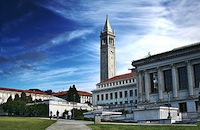
Computational astrophysicists include UC-HIPACC Council member Eliot Quartet, director of Berkeley’s Theoretical Astrophysics Center, Christopher McKee and Richard Klein, who are working on star formation, Jonathan Arms on compact objects, Daniel Kasen on high energy astrophysics, and cosmologists Chung-Pei Ma, Uros Seljak, and Martin White. White is involved in major collaborations with LANL; there are also collaborations with LBNL. Saul Perlmutter heads the Berkeley Institute for Data Science (BIDS). Joshua Bloom, an expert on data-driven astronomical inference and machine learning, is Co-PI of BIDS. Berkeley also hosts an exceptional group of postdoctoral computational astrophysicists.
UC Irvine
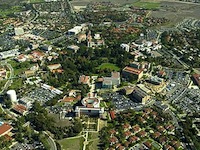
The UC Irvine Center for Cosmology hosts 21 full-time faculty members with interests that range from theoretical particle physics in the early universe to astronomical observations of high-redshift galaxies, to understanding the formation of the Milky Way galaxy. Three Center for Cosmology faculty members (UC-HIPACC Council member James S. Bullock, Asantha R. Cooray, and Manoj Kaplinghat) and ten to fifteen postdoctoral researchers and graduate students per year are actively involved in high-performance computer simulations to study the assembly of galaxies and galaxy interactions, to analyze large data sets in order to measure the clustering of galaxies in the early universe, to understand the propoerties of small satellite galaxies of the Milky Way and Andromeda, and to study the properties of different types of dark matter candidates. The astrophysics group at Irvine also interacts frequently with Wayne Hayes from the Computer Science Department at UC Irvine. UC irvine is the headquarters for the new UC Center for Galactic Evolution (CGE), a consortium of the four Southern California campuses.
UC Los Angeles
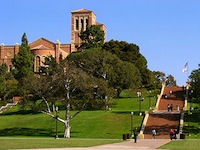
UCLA and HiPACC Council member Steve Furlanetto focuses on the formation of the first galaxies in the universe, research that is particularly relevant to the NASA James Webb Space Telescope and to the Thirty Meter Telescope. Other faculty at UCLA, including both theoretical and observational astronomers, use high-performance computing to study areas from planet formation and the dynamics of the solar system to supermassive black holes.
UC Merced
At this newest UC campus, UC-HiPACC Wil van Breugel studies distant massive galaxies, Lilian Davila interstellar dust, and Mayya Tokman computational science especially applied to plasma physics. The UC Merced graduate program in applied mathematics focuses on scientific computing.
UC Riverside
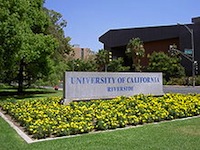
The focus at UC Riverside is on observational astronomy, including galaxy formation and evolution. They are major collaborators on the CANDELS progem. UC-HIPACC workshops, conferences, and summer schools are of particular value to the students and postdocs at UC Riverside.
UC San Diego
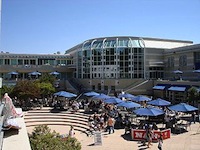
The UC San Diego Laboratory for Computational Astrophysics (LCA), directed by UC-HIPACC Council member and Southern California coordinator Michael Norman (director of the San Diego Supercomputer Center (SDSC)), is currently developing the adaptive mesh refinement hydrodynamic cosmology code ENZO for petascale platforms. Research applications are being made to precision simulations of the Lyman alpha forest, the formation and evolution of the first galaxies, and cosmic reionization. The LCA is also active in the International Virtual Observatory Alliance (IVOA) Theory Data Working Group, and is developing access protocols for astrophysical simulation data. Other UCSD computational astrophysicists include Paolo Padoan, Alexei Kritsuk, and several postdocs and other staff.
UC Santa Cruz
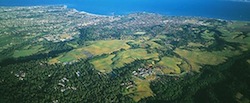
At UC Santa Cruz, headquarters for UC-HiPACC, a large group of computational astrophysicists are working on:
- Solar and planetary physics: Eric Asphaug, Gary Glatzmaier, and Francis Nimmo (Department of Earth and Planetary Sciences) and Nic Brummell and Pascale Garaud (Applied Math and statistics);
- Stars and planetary systems: Jonathan Fortney, Greg Laughlin, Douglas Lin, and Adriane Steinacker (Astronomy);
- Star formation: Mark Krumholz (Astronomy);
- Compact objects and supernovae: Enrico Ramirez-Ruis and Stan Woosley (Astronomy);
- Cosmology, galaxy formation, and high-energy astrophysics: Charlie Conroy and Piero Madau (Astronomy) and Anthony Aguirre, Joel Primack, and Stefano Profumo (Physics)
Primack’s postdoc Patrik Jonsson developed the Sunrise code to generate images of simulated galaxies, including scattering, absorption, and re-emission by dust. UC Santa Cruz is the headquarters of the University of California Observatories/Lick Observatory (UCO/Lick), and many UCSC observational astronomers, including UC-HIPACC Council member Sandra Faber, are involved in computational astrophysics. Faber leads the CANDELS collaboration, with the largest ever grant of Hubble Space Telescope time. In addition, several Physics faculty associated with the Santa Cruz Institute for Particle Physics (SCIPP) are involved in gamma ray astronomy with the Fermi spacecraft and the VERITAS array of atmospheric Cherenkov telescopes. There are more than 20 UCSC postdocs in related areas. UCSC also has an 800+ processor mini-supercomputer for astrophysics, which is used by both theorists and observers.
Lawrence Berkeley National Laboratory
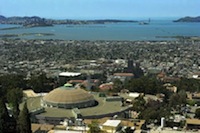
The LBNL Physics and Computational Research Divisions have formed the Computational Cosmology Center (C3), a focused collaboration of astrophysicists and computational scientists. Its goals are to develop the tools, techniques and technologies to meet the analysis challenges posed by present and future cosmological data sets, including for the Planck and JDEM satellite missions, which will gather data sets so massive that their analysis requires leading-edge high performance computing resources. Among the senior people involved in these efforts are computational astrophysicists Julian Borrill and UC-HIPACC Council member and Northern California coordinator Peter Nugent, computational scientists John Bell and Phil Colella, and observational cosmologists David Schlegel and 2011 Nobel laureate Saul Perlmutter. Berkeley and LBNL hosted HiPACC's 2011 international summer school on Computational Explosive Astrophysics.
Los Alamos National Laboratory
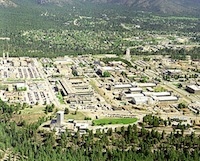
LANL has a long history in cutting-edge supercomputing. LANL astrophysical and cosmological simulations cover areas such as the large scale structure of the universe, cosmological hydrodynamics, astro-MHD simulations, stellar astrophysics including simulations of supernova explosions and light curves, nuclear astrophysics, simulations of the first stars, planet formation, space plasma simulations, the Lyman-alpha forest, and the epoch of reionization. Observational areas include astrophysical transients, high-energy astrophysics, X-ray astronomy, optical surveys, space exploration, and radio astronomy. LANL people involve in this include Chris Fryer, UC-HIPACC Council member Tom Vestrand, Katrin Heitmann, and Mike Warren.
Lawrence Livermore National Laboratory
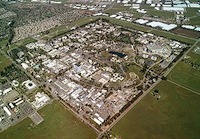
Likewise, LLNL has a long history in cutting-edge supercomputing, especially in collaborating with Los Alamos on simulations and observations. LLNL people include UC-HIPACC Council member Peter Anninos, Rob Hoffman, Stephen Murray, and Jay Salmonson.
